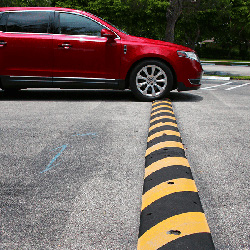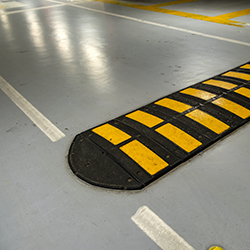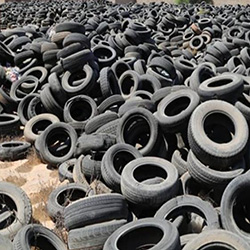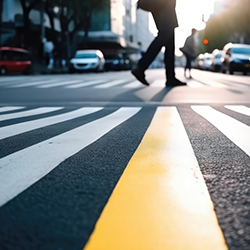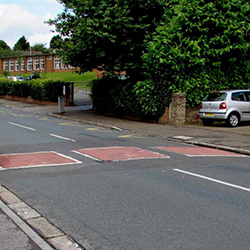All posts by Marco Varela
Enhancing Pedestrian Safety with Speed Bumps and Humps
Introduction
Importance of pedestrian safety
Pedestrian safety is of utmost importance in today’s fast-paced world. With the increase in traffic and the growing number of vehicles on the road, it is crucial to implement effective measures to ensure the safety of pedestrians. Speed bumps and humps play a significant role in enhancing pedestrian safety. These traffic calming devices help to reduce vehicle speed, making it safer for pedestrians to cross the road. By slowing down vehicles, speed bumps and humps provide a visual cue to drivers to be more cautious and attentive, ultimately reducing the risk of accidents and improving pedestrian safety. Implementing these measures not only protects pedestrians but also promotes a sense of community and encourages more people to choose walking as a mode of transportation. Therefore, it is essential to recognize the importance of pedestrian safety and take proactive steps in implementing measures like speed bumps and humps to create safer and more walkable neighborhoods.
Overview of speed bumps and humps
Speed bumps and humps are traffic calming measures designed to reduce vehicle speeds and enhance pedestrian safety. They are typically installed on residential streets, parking lots, and other areas with high pedestrian activity. Speed bumps are raised sections of pavement that force drivers to slow down, while speed humps are longer and flatter, allowing vehicles to maintain a slightly higher speed. Both speed bumps and humps serve as visual and physical cues to drivers, reminding them to be cautious and watch for pedestrians. By effectively slowing down vehicles, these traffic calming measures help create a safer environment for pedestrians and reduce the risk of accidents and injuries.
Purpose of the article
The purpose of this article is to explore the effectiveness of speed bumps and humps in enhancing pedestrian safety. With the increasing number of accidents involving pedestrians, it is crucial to implement measures that can reduce vehicle speeds and improve safety on roads. Speed bumps and humps have been widely used as traffic calming measures to slow down vehicles in areas with high pedestrian activity. This article will discuss the benefits of speed bumps and humps in reducing vehicle speeds, enhancing driver awareness, and ultimately creating safer environments for pedestrians.
Types of Speed Bumps
Traditional speed bumps
Traditional speed bumps are a common method used to control vehicle speed and enhance pedestrian safety. These raised sections of pavement are typically found on residential streets, parking lots, and school zones. They are designed to force drivers to slow down by creating a jarring sensation when a vehicle passes over them. The purpose of traditional speed bumps is to reduce the risk of accidents, especially in areas where pedestrians are present. By effectively slowing down vehicles, speed bumps help to create a safer environment for pedestrians, encouraging drivers to be more cautious and alert. However, traditional speed bumps also have some drawbacks. They can cause discomfort and inconvenience for drivers, particularly those in emergency vehicles or vehicles with low ground clearance. Additionally, speed bumps may contribute to noise pollution and increase fuel consumption. Despite these limitations, traditional speed bumps remain a widely used tool in improving pedestrian safety.
Speed humps
Speed humps are an effective traffic calming measure that can greatly enhance pedestrian safety. These raised devices, typically made of asphalt or rubber, are strategically placed on roadways to slow down vehicle speeds. By forcing drivers to reduce their speed, speed humps help create a safer environment for pedestrians, especially in areas with high foot traffic such as residential neighborhoods, school zones, and shopping centers. The presence of speed humps also serves as a visual reminder for drivers to be more cautious and attentive, reducing the risk of accidents and improving overall road safety.
Raised crosswalks
Raised crosswalks, also known as speed humps or speed bumps, are an effective measure to enhance pedestrian safety. These elevated structures are designed to slow down vehicle traffic at designated crossing points, making it safer for pedestrians to cross the road. By forcing drivers to reduce their speed, raised crosswalks help to prevent accidents and promote a safer environment for pedestrians. Additionally, the visibility of these raised structures serves as a visual cue for drivers to be more cautious and attentive while approaching and crossing the crosswalk. Overall, raised crosswalks play a crucial role in ensuring pedestrian safety and should be considered as a key component in any traffic calming strategy.
Benefits of Speed Bumps and Humps
Reduced vehicle speed
Reduced vehicle speed is one of the key benefits of implementing speed bumps and humps to enhance pedestrian safety. By introducing these traffic calming measures, drivers are forced to slow down, creating a safer environment for pedestrians. The presence of speed bumps and humps encourages drivers to be more cautious and attentive, reducing the risk of accidents and potential injuries. Moreover, the reduced speed allows pedestrians to have more time to cross the road safely, especially in high-traffic areas or near schools and residential neighborhoods. Overall, the implementation of speed bumps and humps plays a crucial role in reducing vehicle speed and ensuring the safety of pedestrians.
Increased pedestrian safety
Increased pedestrian safety is a crucial aspect of urban planning and traffic management. One effective measure that has been widely adopted is the installation of speed bumps and humps. These physical traffic calming devices are strategically placed on roads to slow down vehicles and encourage drivers to be more cautious. By reducing vehicle speeds, speed bumps and humps help create a safer environment for pedestrians, especially in areas with high foot traffic such as residential neighborhoods, school zones, and shopping centers. Studies have shown that the presence of speed bumps and humps can significantly decrease the number of accidents involving pedestrians, making them an essential tool in enhancing pedestrian safety.
Improved traffic calming
Improved traffic calming measures, such as speed bumps and humps, have proven to be effective in enhancing pedestrian safety. By reducing vehicle speeds in residential areas and near schools, these traffic calming devices help create a safer environment for pedestrians to walk and cross the streets. The presence of speed bumps and humps serves as a visual reminder for drivers to slow down, making them more aware of their surroundings and the need to yield to pedestrians. Additionally, these measures encourage responsible driving behavior and discourage reckless speeding, ultimately reducing the risk of accidents and injuries. Overall, the implementation of speed bumps and humps as part of traffic calming initiatives plays a crucial role in improving pedestrian safety and creating more walkable communities.
Design Considerations
Placement of speed bumps and humps
The placement of speed bumps and humps plays a crucial role in enhancing pedestrian safety. These traffic calming measures are typically installed in areas with high pedestrian activity, such as residential neighborhoods, school zones, and parking lots. The strategic placement of speed bumps and humps helps to slow down vehicles, forcing drivers to reduce their speed and be more cautious. They are often positioned near crosswalks, intersections, and areas where there is a higher risk of pedestrian accidents. By effectively controlling the speed of vehicles, speed bumps and humps contribute to creating a safer environment for pedestrians, reducing the likelihood of accidents and promoting pedestrian-friendly spaces.
Height and width specifications
Height and width specifications play a crucial role in the effectiveness of speed bumps and humps in enhancing pedestrian safety. These specifications determine the level of impact on vehicles and the speed at which drivers need to slow down. Generally, speed bumps are designed to have a height of 3 to 4 inches and a width of 12 to 14 feet, while speed humps have a height of 3 to 4 inches and a width of 22 to 24 feet. These dimensions are carefully chosen to ensure that drivers are forced to reduce their speed and pay attention to pedestrians, creating a safer environment for everyone. Moreover, adhering to these specifications ensures consistency in the implementation of speed bumps and humps, allowing drivers to anticipate and adjust their driving behavior accordingly.
Materials used
In order to enhance pedestrian safety, various materials are used for constructing speed bumps and humps. These materials are specifically designed to withstand heavy traffic and adverse weather conditions. Common materials include rubber, asphalt, concrete, and plastic. Rubber speed bumps are popular due to their durability and flexibility, which allows them to absorb impact and reduce vehicle speed effectively. Asphalt and concrete speed bumps are known for their strength and longevity, making them suitable for high-traffic areas. Plastic speed bumps are lightweight and easy to install, making them a cost-effective option for temporary traffic control. Overall, the choice of materials for speed bumps and humps depends on the specific requirements of the location and the desired level of effectiveness in slowing down vehicles and ensuring pedestrian safety.
Challenges and Limitations
Impact on emergency vehicles
Speed bumps and humps have a significant impact on emergency vehicles. While these traffic calming measures are effective in reducing vehicle speeds and improving pedestrian safety, they can also slow down emergency response times. The raised surfaces of speed bumps and humps require emergency vehicles to reduce their speed, which can delay their arrival at the scene of an emergency. This delay can have serious consequences, especially in life-threatening situations where every second counts. Therefore, it is crucial to carefully consider the placement and design of speed bumps and humps to minimize their impact on emergency vehicles while still ensuring the safety of pedestrians.
Noise and vibration
Noise and vibration are important factors to consider when implementing speed bumps and humps for pedestrian safety. Speed bumps and humps can generate noise and vibrations, especially when vehicles pass over them at high speeds. This can be a concern for nearby residents, as excessive noise and vibrations can disrupt their daily lives and affect their quality of life. Therefore, it is crucial to design and install speed bumps and humps in a way that minimizes noise and vibrations while still effectively slowing down vehicles and ensuring pedestrian safety. Various measures, such as using materials with noise-dampening properties and implementing proper installation techniques, can help mitigate the noise and vibration impact of speed bumps and humps. By addressing these concerns, we can enhance pedestrian safety without compromising the well-being of the surrounding community.
Maintenance and cost
Maintenance and cost are important considerations when implementing speed bumps and humps for enhancing pedestrian safety. Regular maintenance is necessary to ensure that the speed bumps and humps are in good condition and functioning effectively. This includes inspecting and repairing any damage, repainting the markings, and cleaning the surfaces. The cost of maintenance can vary depending on the material used for the speed bumps and humps, the frequency of maintenance, and the size of the installation. However, the investment in regular maintenance is crucial to ensure the long-term effectiveness and safety of these traffic calming measures.
Case Studies
City A: Effectiveness of speed bumps
Speed bumps have been widely implemented in City A as a measure to enhance pedestrian safety. These physical traffic calming devices are strategically placed on roads with high pedestrian activity to reduce vehicle speeds. The effectiveness of speed bumps in City A has been well-documented, with studies showing a significant decrease in the number of accidents involving pedestrians. The presence of speed bumps not only forces drivers to slow down but also increases their awareness of pedestrians, making the streets safer for everyone. Additionally, speed bumps have been found to promote a sense of community and encourage active transportation by creating a more pedestrian-friendly environment. Overall, the implementation of speed bumps in City A has proven to be an effective strategy in improving pedestrian safety and fostering a safer and more livable city.
City B: Implementation of speed humps
City B has implemented speed humps as a measure to enhance pedestrian safety. These speed humps are strategically placed in areas with high pedestrian activity, such as school zones and residential neighborhoods. The implementation of speed humps has proven to be effective in slowing down vehicles and reducing the risk of accidents. By forcing drivers to reduce their speed, speed humps provide a safer environment for pedestrians to cross the road. City B’s commitment to pedestrian safety is commendable, and the use of speed humps is a valuable tool in achieving this goal.
City C: Success of raised crosswalks
City C has seen great success in enhancing pedestrian safety through the implementation of raised crosswalks. These raised crosswalks, also known as speed bumps and humps, have proven to be effective in reducing vehicle speeds and increasing awareness of pedestrians. The city has strategically placed these raised crosswalks in high pedestrian traffic areas, such as near schools, parks, and residential areas. As a result, there has been a significant decrease in the number of pedestrian accidents and injuries. The success of raised crosswalks in City C serves as a model for other cities looking to improve pedestrian safety and create a more walkable environment.
Why is a hump called a hump?
Introduction
Navigating the landscape of our roads, you’ve likely encountered those familiar humps known as speed bumps. Used as traffic calming measures, these bumps are designed to keep lead-footed drivers in check, especially in zones where safety is paramount such as schools, residential areas, and commercial premises. But like most things in life, speed bumps come with their fair share of controversy and debate. Continue reading “Why is a hump called a hump?” »FUN FACTS about speed bumps
Introduction
In today’s fast-paced world, the need for speed often trumps safety considerations. Yet, when it comes to residential areas, the narrative needs to shift from speed to safety. Enter speed bumps – the raised traffic calming devices strategically placed on our roads and parking lots. Their role? To encourage responsible driving by reducing vehicle speeds. In this article, we delve into the importance of installing speed bumps in residential areas, their role in reducing the risk of accidents, and promoting safer driving conditions. So, buckle up and join us on this ride to understanding these unassuming safety guardians of our neighborhoods. Continue reading “FUN FACTS about speed bumps” »Are there any other traffic calming methods?
Introduction
Speed bumps, those ubiquitous mounds that command our attention and obedience on the roads, are the subject of much debate. Are they an effective guardian of road safety or merely an annoyance to drivers? This question may have crossed your mind as you gingerly navigated your vehicle over one of these asphalt speed regulators. In this article, we’re stepping on the brakes to delve deeper into the world of speed bumps, and to bring you a comprehensive guide. Continue reading “Are there any other traffic calming methods?” »What do people call speed bumps?
Introduction
Imagine driving through the streets of London, then hopping over to Wellington, only to jet off to the sunny Caribbean. Your journey’s constant companion? That familiar bump on the road, known to many as the humble speed bump. However, in the world of linguistics, this ubiquitous road feature takes on as many aliases as a globe-trotting spy. Continue reading “What do people call speed bumps?” »Why is there a gap in speed bumps?
Introduction
In the world of traffic management, speed bumps have long been the guardians of safety, slowing down vehicles to a crawl. However, their design, essentially a raised bump across the breadth of the road, can often impede the swift passage of emergency vehicles. Imagine an ambulance racing to save a life only to be slowed down by a series of speed bumps. This brings us to the curious question which is the focus of our discussion: Why is there a gap in speed bumps? Continue reading “Why is there a gap in speed bumps?” »How many countries have speed bumps?
Introduction
Welcome to the fascinating world of traffic calming measures! These life-saving tools, often overlooked, are strategically strewn across our roads to ensure pedestrian safety. Among the various forms – speed bumps, chicanes, pinch points, to name a few – the humble speed bump stands out due to its ubiquity. Continue reading “How many countries have speed bumps?” »The Benefits of Speed Bumps and Speed Humps in Reducing Car Accidents
What are speed bumps and speed humps?
Speed bumps and speed humps are traffic calming devices that are commonly used to slow down vehicles and improve road safety. They are physical raised structures placed on the road surface, designed to force drivers to reduce their speed. Speed bumps are typically shorter and steeper, while speed humps are longer and more gradual. Both types of devices are usually made of asphalt or concrete and are marked with reflective paint for increased visibility. Speed bumps and speed humps are often installed in areas with high pedestrian activity, such as school zones, residential neighborhoods, and parking lots, to ensure the safety of pedestrians and prevent accidents. Continue reading “The Benefits of Speed Bumps and Speed Humps in Reducing Car Accidents” »Speed bumps Versus Speed humps, what is the difference?

To promote cautious driving in pedestrian zones, both speed bumps and humps are effective.
Speed zones are often put up to promote safe driving. Still, since the written restrictions are often forgotten or ignored, the physical design of the highway or surrounding environment is typically used to reduce traffic congestion in these locations. Speed bumps and speed humps are vertical traffic control barriers that bump in the road that cause the passengers of a car traveling too rapidly over them to be jolted awake. According to statistics, they are the most often employed structural traffic calming components on the road today. They may be composed of various materials, including asphalt, concrete, plastic, rubber, and metal. These measurements are linked and have many of the same advantages; yet, they are not interchangeable solutions; they are each good for a specific application in their own right.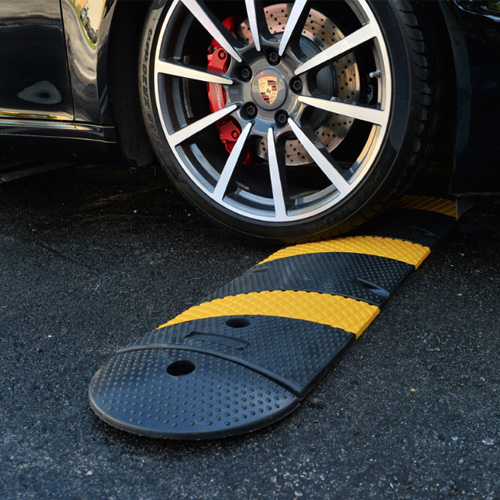
| SKU | Description | Length | Height | Width | Weight |
|---|---|---|---|---|---|
| SB206FT | 6 Ft Speed Bump (1) 6′ Section With no End Caps | 72″ | 2″ | 12″ | 48.40 |
| SB207FT | 7 Ft Speed Bump (1) 6′ Section + (2) End Caps | 86″ | 2″ | 12″ | 55.40 |
| SB213FT | Single Lane 12 Ft Speed Bump (2) 6′ Section With no End Caps | 144″ | 2″ | 12″ | 96.80 |
| SB219FT | Double lane 19 Ft Speed Bump (3) 6′ Section + (2) End Caps | 230″ | 2″ | 12″ | 152.20 |
| SB225FT | 25 Ft Speed Bump (4) 6′ Section + (2) End Caps | 302″ | 2″ | 12″ | 200.60 |
| SB2ECAP | End cap | 7′ | 2′ | 12′ | 3.50 |
| SKU | Description | Length | Height | Width | Weight |
|---|---|---|---|---|---|
| SB3039I | 39″ Speed Bump (1) 39″ Section With no End Caps | 39″ | 2″ | 13.7″ | 36.20 |
| SB3117I | 117″ Single Lane Speed Bump (3) 39″ Sections With no End Caps | 117″ | 2″ | 13.7″ | 108.60 |
| SB3137I | 137″ Single Lane Speed Bump (3) 39″ Sections + (2) End Caps | 137″ | 2″ | 13.7″ | 124.20 |
| SB3234I | 234″ Double lane Speed Bump (6) 39″ Sections With no End Caps | 234″ | 2″ | 13.7″ | 217.20 |
| SB3254I-2 | 254″ Double Lane Speed Bump (6) 39″ Sections + (2) End Caps | 254″ | 2″ | 13.7″ | 232.80 |
| SB3ECAP-2 | End cap | 10″ | 2″ | 13.7″ | 7.80 |
| SKU | Description | Length | Height | Width | Weight |
|---|---|---|---|---|---|
| SH1018I | 18.75″ Speed Bump (1) 18.75″ Section with no End Caps | 18.75″ | 1.25″ | 2″ | 22.20 |
| SH1112I | 112.5″ Single Lane Speed Bump (6) 18.75″ Sections with no End Caps | 112.5″ | 1.25″ | 2″ | 133.20 |
| SH1128I | 10 Ft Single Lane Speed Bump (6) 18.75″ Sections + (2) End Caps | 128.5 | 1.25″ | 2″ | 148.80 |
| SH1225I | 225″ Double Lane Speed Bump (12) 18.75″ Sections with no End Caps | 225″ | 1.25″ | 2″ | 266.40 |
| SH1241I | 20 Ft Double Lane Speed Bump (12) 18.75″ Sections + (2) End Caps | 241″ | 1.25″ | 2″ | 282.00 |
| SH1ECAL | LEFT End Cap | 8″ | 1.25″ | 2′ | 7.80 |
| SH1ECAR | RIGHT End Cap | 8″ | 1.25″ | 2′ | 7.80 |
| SKU | Description | Length | Height | Width | Weight |
|---|---|---|---|---|---|
| SH2019I | 19.75″ Speed Bump (1) 19.75″ Section With no End Caps | 19.75″ | 2″ | 3″ | 48.00 |
| SH2121I | 10 Ft Single Lane Speed Bump (5) 19.75″ Sections + (2) End Caps | 121.75″ | 2″ | 3″ | 273.00 |
| SH2240I | 20 Ft Double Lane Speed Bump (11) 19.75″ + (2) End Caps | 240″ | 2″ | 3″ | 561.00 |
| SH2ECAL | LEFT End cap | 11.5″ | 2″ | 3′ | 16.00 |
| SH2ECAR | RIGHT End cap | 11.5″ | 2″ | 3′ | 16.00 |
Speed Humps:
On minor streets or connection roads, traffic has to move smoothly, but excessive speed may harm people, they are often observed. A speed hump, also known as road humps or undulations, is a traffic control device used in 10–15 mph zones. These are often used in traffic control in playgrounds and school zones. When a vehicle passes over a speed hump at the legal speed limit, it will experience a moderate rocking feeling in the automobile. If a car is traveling at a hazardous pace, the hump will jolt the vehicle and its contents, causing pain to the people and inflicting damage to the cargo. These obstructions often extend beyond the confines of the lane in which they are installed. Encouraging cars to pass over them with both wheels reduces the probability of a vehicle bottoming out. Speed humps are available in several different profiles and travel lengths. These considerations impact the sensation of pain caused by the fast vehicle. The distance traveled ranges between 3 and 20 feet. There is just one up-and-down motion created by a journey length longer than the vehicle, but a travel length less than the vehicle causes two rocking motions when each pair of wheels passes over. Most of the time, speed humps are positioned in a sequence to maintain the speed restriction throughout a lengthy stretch. They are not suitable for main highways, emergency routes, or any roadway where a motorist may easily avoid the hump by driving on the shoulder. The result is that most of the time, they’re built-in one or two-lane small urban settings with curbs and closed sewers. Whenever speed humps are built in regions with a shoulder, they are sometimes paired with bollards or other obstructive measures to prevent automobiles from off the route.Speed bumps
When compared to speed humps, speed bumps are more forceful traffic calming solutions. As a result, they are excellent in areas where pedestrians and automobiles share space closely, such as parking lots and driveways. A speed bump often slows traffic down to 2–10 mph, providing both people and automobiles enough time to respond safely to one another when they come into contact. Because they require vehicles to come to a near stop to pass over them, speed bumps are seldom utilized on public roads, and they may cause harm to vehicles traveling at standard speeds. Speed bumps may range in height from two to four inches, although they go over a far shorter distance than speed humps do. These obstructions lie beneath a vehicle’s tire for less than half of a whole wheel revolution, and their normal widths range from six inches to two feet in length. The height causes a sudden bounce in a vehicle to travel distance ratio, which may cause both people and cargo to be shaken. Because a speed bump is always far smaller than the cars traveling over it, each axle will cross individually, resulting in a car traveling at excessive speed receiving two significant jolts. Like their more sedate cousins, speed bumps may be put at regular intervals to keep the speed decrease consistent. They are generally placed at strategic intervals because they are more unpleasant to drive over at any speed and serve a limited geographic region. Speed bumps can deliver a jolt, which may explain why they have earned a variety of amusing nicknames across the globe. They are referred to as “dos-d’âne” in French, which means “humpback” in English. They are referred to as speed breakers in India, judder bars in New Zealand, sleeping policemen in the United Kingdom, and road turtles in the United States (Southern US).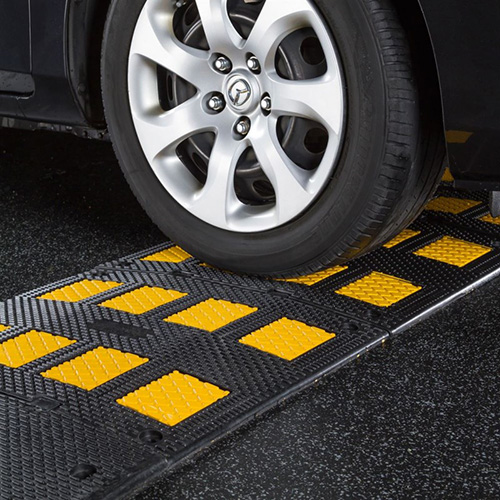
Benefits & Cautions:
One of the most significant advantages of speed bumps and humps is that they retain their effectiveness as a deterrent regardless of how acclimated drivers get to their presence. For a short period, flashing signs or intermittent traffic enforcement might alter motorist behavior, but drivers often return to their former habits. One may choose to ignore a sign, but one cannot ignore the road underneath it. A speed hump or a speed bump causes the same pain for a motorist traveling too rapidly, regardless of whether it is their first or hundredth time passing over one. A bump in the road is not always the best solution for calming traffic situations. Obstacles operate best when the driver is aware that they are approaching and begins to slow down before reaching the obstacle’s edge. Speed bumps and humps are often carefully marked with contrasting colors or reflective surfaces to promote visibility. Still, they must also be located in areas where drivers will see them approaching to be effective. Use of these devices amid a lengthy curve or on streets with grades more than 8 percent is not recommended. A steep incline may also alter the effective height of a speed hump or bump, causing it to have a greater impact than it was originally designed to have. Visibility may also be a problem in certain winter climes, particularly in areas where snowfall is heavy and local roads are not plowed. On arterial or emergency routes where they might pose a safety threat, speed humps and bumps are likewise not advised for installation. A motorist may lose control of his or her car if these obstacles are encountered unexpectedly or while traveling at excessive speeds. However, the most flexible instruments in the traffic management toolkit are those that are utilized in the correct context.Materials and installation
Depending on their purpose, speed bumps and humps are often built of rubber or asphalt. Various materials such as plastic, metal, and concrete are also available. These obstacles, often composed of rubber or plastic, are simple to put on pre-existing surfaces, allowing for a quick and efficient set-up. Both solutions are lightweight and may be deployed just for a short period. Snow removal in winter regions may be difficult by very restricted installations, particularly when several of them are put near together in series. Both rubber and plastic speed bumps can be removed to make these procedures more convenient. As rubber has higher compression than asphalt or concrete, it may be advantageous to a vehicle that strikes it too rapidly, at an angle, or when it is low to the ground, as the vehicle is less likely to sustain damage as a result of the impact. Because of the increased compression, rubber obstacles of the same height are less efficient at delaying traffic than identical asphalt installations. As a result, rubber or plastic obstacles are not recommended for highways where heavy industrial traffic is constantly passing. On the other hand, Rubber is strong and long-lasting under typical circumstances, and it is affordable to purchase and install. Municipal road workers or private paving firms are often tasked with installing asphalt or concrete speed humps. They must be precise and knowledgeable in the field, or else the installation might go wrong. In the hands of suitably skilled staff, asphalt may be used to create obstacles with certain shapes and travel lengths. Because both materials have less compression than rubber or plastic, they are marginally more successful at speed reduction than the other. On the other hand, asphalt and concrete will tend to wear and break over time and under various weather conditions.Bottom Line:
To promote cautious driving in pedestrian zones, both speed bumps and humps are effective. Speed humps are beneficial in locations where traffic must move quickly, while speed bumps are good in tiny spaces where people and vehicles share space more evenly. Both need less preparation than other physical traffic calming systems such as roundabouts or one-way streets, and modular, prebuilt versions may be put quickly and cheaply on existing surfaces. Roundabouts and one-way streets are examples of such approaches. When placed in the proper context, larger speed humps and their smaller but more aggressive siblings, speed bumps, maybe traffic safety superstars when used properly.List of websites with governmental information about speed bumps in the USA:
- Federal Highway Administration (FHWA): The FHWA is a division of the US Department of Transportation, responsible for overseeing the use of speed bumps on federal highways and roadways. Their website contains guidelines and regulations for the use of speed bumps on these roads.
- State Departments of Transportation: Each state has its own department of transportation, responsible for overseeing the use of speed bumps on state-owned roads and highways. Websites for these departments may contain information about regulations and guidelines for speed bumps in their respective states.
- City and County Government Websites: Many cities and counties have their own transportation departments, responsible for overseeing the use of speed bumps on local roads. Websites for these departments may contain information about regulations and guidelines for speed bumps in their respective areas.
- National Institute for Occupational Safety and Health (NIOSH): NIOSH is a division of the Centers for Disease Control and Prevention (CDC), responsible for studying and promoting workplace safety. Their website contains information about the use of speed bumps in workplace settings, including guidelines for their installation and use.
- Occupational Safety and Health Administration (OSHA): OSHA is a division of the US Department of Labor, responsible for promoting workplace safety. Their website contains information about the use of speed bumps in workplace settings, including guidelines for their installation and use.
Websites:
- Federal Highway Administration (FHWA): https://www.fhwa.dot.gov/
- State Departments of Transportation: You can find a list of state transportation departments and their respective websites here: https://www.transportation.gov/state-transportation-links
- City and County Government Websites: The websites for individual cities and counties can vary, but you can typically find them by doing a Google search for the name of the city or county followed by “department of transportation.”
- National Institute for Occupational Safety and Health (NIOSH): https://www.cdc.gov/niosh/index.htm
- Occupational Safety and Health Administration (OSHA): https://www.osha.gov/

